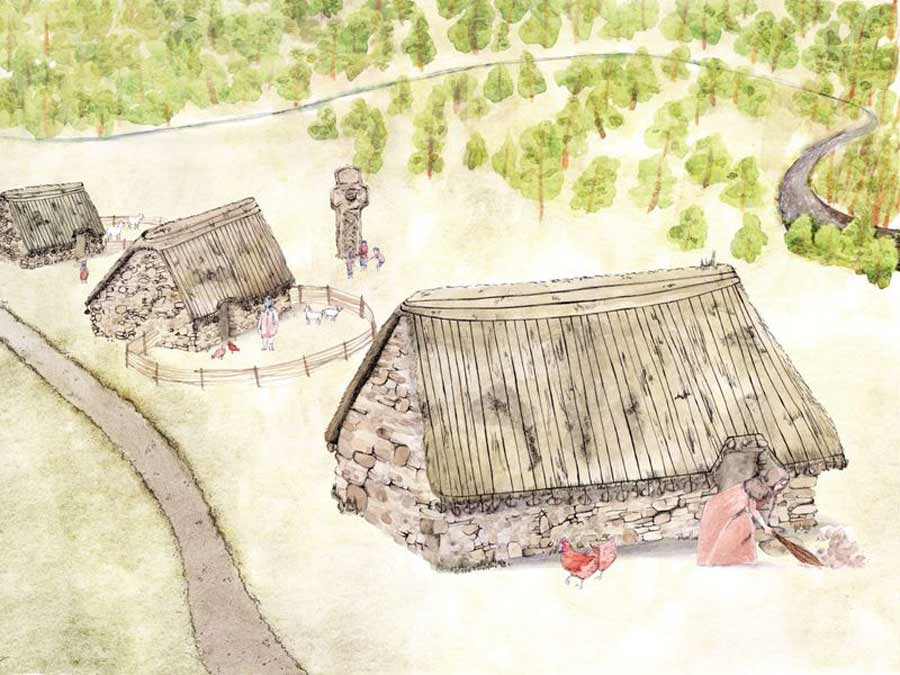Iron Age Dagger and 700-Year-Old Village Found in Scotland Beneath Motorway!
Four buildings, part of a Scottish medieval settlement, discovered beneath a motorway hard shoulder in Scotland in 2016 stood “no chance” of being destroyed over the last 700 years. They were “magically protected” by an Iron Age dagger which archaeologists say was a talisman applied in the battle against malevolent supernatural forces.
On Friday, 26th February 2016, The Scotsman awarded iconic British comedian Ronnie Corbett with Joke of the week. Corbett said, “We've just heard that a juggernaut of onions has shed its load all over the M1. Motorists are advised to find a hard shoulder to cry on.” However, if you were to cry on a particular motorway hard shoulder on the M74 in North Lanarkshire in Scotland your tears would fall on a 700-year-old Scottish medieval settlement.

The M74 construction project near Bothwell, North Lanarkshire, Scotland, where the “Netherton” Scottish medieval settlement was discovered. (GUARD Archaeology)
Medieval Scottish Settlement: Blacksmiths, Tools, Talismans
The remains of the medieval Scottish settlement, dating from the 14th to the 17th century AD, were unearthed on a hard shoulder known as Netherton Cross, near Bothwell, in a North Lanarkshire, Scotland.
- Grand Medieval Building Found Under Welsh Public Restrooms
- Tough Times Call For Tough Measures - The Medieval Village Hierarchy
A recent article in The Scotsman says the discovery is “remarkable,” not only because of the range of buildings from different time periods, but for the quality of the artifacts recovered at the road-side site.
Among the ancient tools discovered at medieval Scottish settlement site was a spindle whorl, spinning yarns, and a whetstone for sharpening agricultural blades that was once spat on.
The archaeologists also found evidence of iron smelting, bloom refining, and blacksmithing based on a collection of nails. And in the 17th century archaeological layer two coins were found.
However, the crown jewel in this discovery was an ancient iron dagger. Dr. Natasha Ferguson, of GUARD Archaeology, one of the co-authors of a new report on the discovery, told Smithsonian that the ancient weapon wasn’t used for fighting, but for “protecting buildings from 'magical' harm.”

The outline of the Iron Age dagger found at the Bothwell Scottish medieval settlement site. (GUARD Archaeology)
The Iron-Age Dagger Protected Settlement From All Demons
Dr. Gemma Cruickshanks, of the National Museums Scotland, said the dagger was covered in a sheath at the time it was buried and that it was “intact and still useable at that time.” It is thought the dagger was made in the Iron Age and that it was carefully deposited during the medieval period at this site in a ritual of some sort.
So far as the nature of the magic being applied here is concerned the researchers assume it was to “protect the building and its inhabitants from some real, or perceived, nefarious outside force.”
Dr Ferguson said the practice of leaving special objects beneath the floors in medieval and post-medieval buildings “was to safeguard the building and its inhabitants from magical harm.” Dr Ferguson wrote that the deposition of these objects under the foundation level of one of the houses “may have been intended to affirm this space as a place of safety for them and generations to come.” And because the dagger was so ancient even in mediaeval times it would have had an “otherworldly appeal,” according to the archaeologist.

The Netherton Cross was moved to its current location, from where it was originally found near Bothwell, to Hamilton Parish Church in 1925. (Transport Scotland)
How Humans Went From Hunting To Medieval Farming Villages
Ever since humans began hunting, and especially with the birth of farming, groups of humans deemed it very important to appease the spirits. However, in today’s modern world science has triumphed over most troublesome “natural” forces, mostly with draft excluders and walls that don’t let wind in.
- Local History Enthusiasts Discover Oldest Medieval Scottish Bridge
- Violent Water and Filth? People Fought Dirty in the Medieval Streets of Aberdeen, Scotland
And in the new world of farming: blizzards, snow and ice generally don’t lead to food scarcity and Armageddon. But in Neolithic times, without computer-aided design, barometers, weather satellites and massive indoor agriculture centers and warehouses, magic, ritual, and sacrifice was the only way to actively try to maintain a cosmic balance and, thus, survival.
With expanding agricultural communities in Iron Age Britain, it became necessary to feed more people including all the field workers and food processing hands, but also builders, craftsmen.
From the original small groups of people making offerings to their gods at specific places that were abundant with natural resources, temporary then permanent settlements grew near these sacred sites which were managed by emerging religious elites. Through organized ritual, like burying swords beneath buildings, together, as communities, we first domesticated ourselves, then plants, then vegetables and finally animals.
Only then did we achieve the luxury of spare time, with which we engineered the Stone Age marvels which pepper Britain’s landscapes today.
Top image: Artist’s reconstruction of the structures at the site of Netherton Cross. Source: Jennifer Colquhoun / GUARD Archaeology
By Ashley Cowie

















